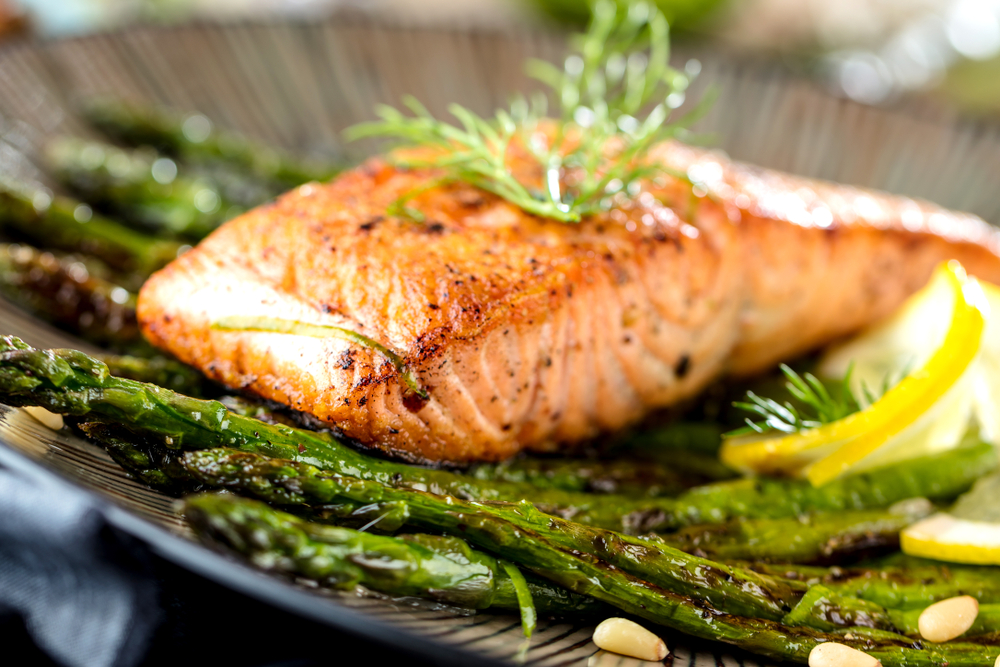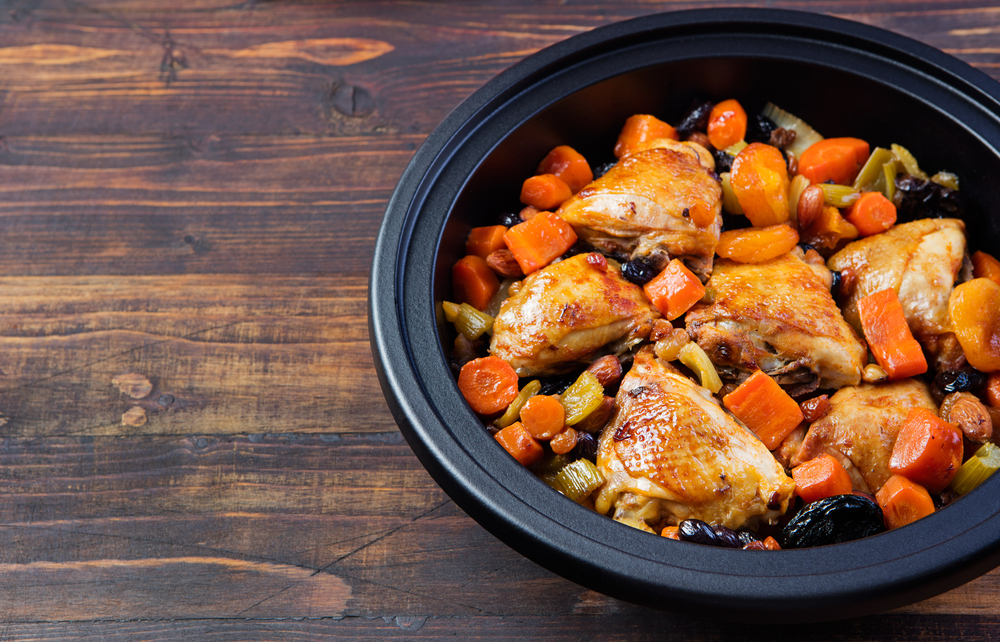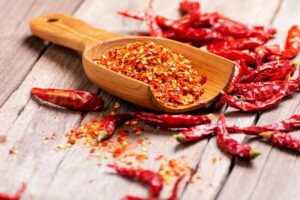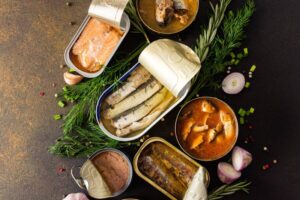Inflammation can either help your body or impact it negatively. The process through which your body releases white blood cells is meant to fight off infection or injury. In other words, it helps to protect you from infections or any foreign pathogens.
However, inflammation can also turn into your body’s enemy. If it becomes chronic, then it can lead to a variety of chronic diseases like cardiovascular disease, diabetes, or cancer. That’s why it’s essential to know how to fight it.
According to Paulina Lee, registered dietitian, “There is increasing acknowledgment between inflammation and its relationship with chronic diseases”. This being said, it’s important to maintain inflammation within healthy ranges to prevent or manage the disease.
There are several ways to do that, including different dietary habits, as some foods provide anti-inflammatory properties that can help control inflammation, so it doesn’t become a chronic problem. Here are 4 sheet-pan recipes that will help you to do so!

Butter-Baked Salmon and Asparagus
Servings: 2
Cook Time: 30 minutes
Salmon and asparagus? This surely sounds like the perfect combination — especially in this friendly recipe topped with butter. This meal is high in omega-3 fatty acids, which can reduce the production of molecules linked to inflammation. But that’s not all. Omega-3s can also lower blood pressure, aid healthy brain function, and reduce the risk of a heart attack.
Ingredients
- 2 fresh salmon fillets, skin-on
- ½ pound fresh asparagus spears, trimmed
- 3 Tablespoon butter
- ⅓ cup mayonnaise
- 1 teaspoon lemon juice
- ¼ teaspoon finely shredded lemon peel
- 1 Tablespoon chopped green onion
- 2 teaspoons fresh flat-leaf parsley (chopped)
- ¼ teaspoon salt
- ⅛ teaspoon black pepper
Directions
- Preheat the oven to 400°F. Next, melt the butter in a saucepan.
- Place the salmon on a baking sheet, skin side down. Place the asparagus next to the fish. Drizzle melted butter and sprinkle with salt and pepper. Bake for about 12-15 minutes or until the salmon turns pink and the asparagus is fork-tender.
- In a small bowl, combine lemon juice, mayonnaise, parsley, green onion, and lemon peel. Serve along with roasted salmon and asparagus. Top with additional parsley (optional). Enjoy!
Sheet Pan Salmon Fajitas
Servings: 6
Cook Time: 35 min
This recipe pairs salmon filet with green, yellow, and red bell peppers, onion, and lots of seasoning to boost each ingredient’s flavor. But that’s not all. This meal is also great at reducing inflammation because salmon provides polyphenols, a compound known to have anti-inflammatory properties.
According to healthcare experts, salmon contains polyphenols, like anthocyanins and curcumin, which boast antioxidants that reduce inflammation and support oxidative stress.
Ingredients
- 10 oz. salmon fillet
- 1 green pepper (sliced)
- 1 yellow pepper (sliced)
- 1 red pepper (sliced)
- 1 large onion (halved and cut slices)
- ⅓ c. olive oil
- 2 tsp. cumin
- 1 Tbsp. chili powder
- ½ tsp. garlic powder
- 1 tsp. salt
- ½ tsp. ground pepper
- pinch of chili flakes
- Cotija or Feta cheese (optional)
For the spicy cream sauce:
- ¼ c. mayonnaise
- ¼ c. light sour cream
- 2 Tbsp. hot sauce
- 2 Tbsp. ketchup
Directions
- Preheat the oven to 400°F. Line a large sheet pan with parchment or foil. Set it aside.
- In a small bowl, combine oil, cumin, chili powder, garlic, chili flakes, salt, and pepper.
- Place salmon fillet on the sheet pan and brush with the olive oil mixture.
- Toss the remaining olive oil mixture with vegetables and add them to the sheet pan, making sure they are spread around the salmon.
- Bake for about 25 minutes or until salmon is cooked and the vegetables are fork-tender with a crispy edge.
- Combine all the ingredients to make the spicy cream sauce.
- Serve with sour cream, avocado, and tortillas. Enjoy!
Read on to find out about other delicious recipes that can help reduce inflammation!

Sheet Pan Moroccan Chicken
Servings: 2
Cooking Time: 50 min
Maybe you got bored, and you want to try something new. Morocco is one of the best inspirations to look for culinary delight, and while North African-inspired cuisine may seem intimidating for any budding chef, this simple recipe only takes 50 minutes to prepare.
While the berries may not be the main attraction in this flavorful dish, they are what provide it its anti-inflammatory properties. Berries, along with salmon and fermented foods, are packed with polyphenols, which are known to fight inflammation.
Ingredients
- 1½ p. boneless skinless chicken thighs (or chicken breasts)
- 2 c. cauliflower florets
- 2 c. of sweet potato chopped into pieces
- 2 onions, cut into chunks
- 2 c. carrot slices
- 2 Tbsp. olive oil
- 1½ tsp. ground turmeric
- 1½ tsp. ground cumin
- 1½ tsp. ground cinnamon
- ½ tsp. garlic powder
- ½ tsp. salt
- ¼ tsp. cayenne pepper
- ½ freshly ground black pepper
To garnish:
- ⅓ c. unsweetened dried cherries (you can replace them with dried cranberries)
- ¼ c. chopped roasted pistachios
- ¼ c. diced cilantro
For the feta yogurt sauce:
- ⅓ c. plain Greek yogurt
- 1 large garlic clove
- ¼ c. feta crumbles
- ½ Tbsp. fresh lemon juice
- salt and pepper to taste
- 1 Tbsp. water, to thin
Directions
- Preheat the oven to 425°F. Line a large baking sheet with foil or parchment paper. Set aside.
- In a large bowl, add chicken thighs, cauliflower, sweet potato cubes, carrot chunks, and onion chunks. Add in olive oil, cinnamon, turmeric, garlic powder, cayenne pepper, cumin, and salt and pepper. Toss everything together until well combined. Make sure all spices evenly coat chicken and vegetables.
- Pour onto the prepared baking sheet. You’ll want to group the veggies as best as possible: chicken in one section, carrots in one section, cauliflower in one section, and onion and sweet potatoes in one section. Bake for about 30 minutes, stirring veggies and rotating the pan halfway through to ensure even cooking. The food is done cooking when the sweet potatoes and carrots are fork tender.
- Meanwhile, you can prepare the feta yogurt sauce by mixing garlic, feta, yogurt, water, and lemon juice in a food processor; process until smooth. Add salt and pepper to taste. Process once more, then set it aside.
- Once chicken and vegetables are cooked through, remove the pan from the oven and immediately sprinkle cilantro, pistachios, and dried cherries on top. You can either serve the feta yogurt sauce on the side or drizzle it on top of the meal. Enjoy!
Potato, Salmon, and Asparagus
Servings: 4
Cook Time: 1 h
Fish is well known to fight inflammation because of its high amounts of omega-3 fatty acids, but that’s not the only food on the plate helping to reduce inflammation. Asparagus has also been found to provide anti-inflammatory properties.
Although this meal is pretty high in sodium, it’s quite low in fat and calories, so as long as your diet doesn’t contain total salt bombs, this is a relatively healthy option.
Ingredients
- 8 oz. salmon fillets
- 15 oz. potatoes, cut in half
- 1 bunch of asparagus spears, or about 25 spears
- ⅓ tsp. paprika
- 1 tsp. salt
- ½ tsp. ground pepper
- ⅓ tsp. ground mustard
- ground ginger (optional)
- lemon slices (optional)
- 3 Tbsp. olive oil
- 4 garlic cloves, minced
Directions
- In a ziplock bag, combine potatoes, olive oil, garlic, salt, and ground pepper. Toss until the potatoes are thoroughly coated. Line a baking sheet with parchment paper or foil. Place the potatoes cut side down.
- Bake at 450°F for 20 minutes, then flip the potatoes cut side up. Bake until potatoes are slightly soft, or for another 10 minutes.
- Move the potatoes to one side of the baking sheet pan, making space for asparagus and salmon.
- Place the salmon onto the baking sheet, spacing each fillet 1 inch apart. Brush the top with oil and garlic. Sprinkle with salt, paprika, ground mustard, and ground ginger.
- In a bowl, season the asparagus with salt, pepper, and the remaining oil and garlic mixture. Place the veggies onto the baking sheet. Next, bake at 450°F for about 12 minutes, depending on the thickness of the fish.
- Remove the sheet pan from the oven. Enjoy!
While these recipes may help you reduce inflammation, keep in mind that you should talk to your doctor first. Here are 5 Signs Your Body Has Inflammation.







